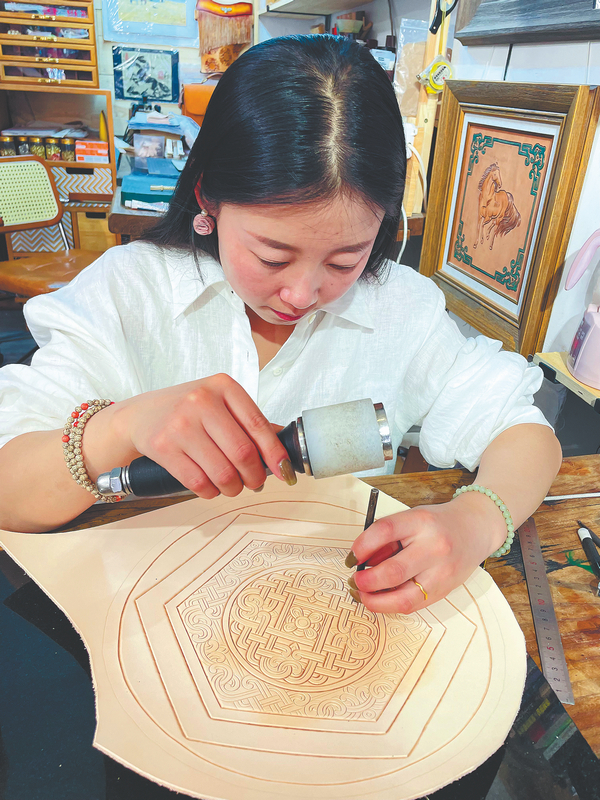Carving a hidden gem of heritage
Craftswoman devotes herself to ethnic Mongolian art, launching her own brand to give 'gifts from a friend', Li Yingxue reports.

Li Xiaofang (center) works on leather carving in Hohhot, Inner Mongolia autonomous region.CHINA DAILY
How much impact can a single elective course have? For Li Xiaofang, one made a great impact on her entire career.
Born in 1994 in Tongliao, Inner Mongolia autonomous region, Li was a junior studying art design at Inner Mongolia University when she enrolled in a class on traditional ethnic Mongolian leather carving, a national intangible cultural heritage, a decision that changed her life. After graduating, she founded her studio and devoted herself to the craft ever since.
Today, her studio Sange Xiangpijiang (Three Fragrant Leather Artisans) is nestled on Saishang Old Street in Hohhot and has become a must-visit tourist destination. This year, she launched her own brand Naijili, which means "a gift from a friend" in Mongolian.
"I hope what people take home is a gift from a friend," she says.
Blending tradition with modern appeal, Li is infusing leather carving with elements of Chinese culture and contemporary design. From bamboo-inspired necklaces to handbags that combine handweaving with intricate carvings, such as playful cats and dogs, she continues to explore new possibilities for the ancient craft, one piece at a time.

A leather-carved painting with a bull head pattern by Li CHINA DAILY
Down to the details
Growing up, Li had little exposure to leather carving, despite her ethnic Mongolian heritage. It wasn't until college that she discovered the craft. In class, she was struck by the intricate beauty of leather art.
Leather carving is an intricate process that requires dozens of steps from selecting leather and sketching patterns to carving, hammering, and coloring. Each detail contributes to the raised, textured designs that define the craft.
With a background in fine arts, Li started from scratch, mastering each technique step by step. After the semester ended, she continued refining her skills in her spare time. What began as small projects like wallets and belts quickly gained traction as friends and acquaintances took notice. Orders soon followed.
Encouraged by the demand, Li took a leap of faith. After graduating in 2016, she and a classmate who is now her husband, opened a leather carving studio in Hohhot.

A leather-carved painting titled Auspicious Grassland by Li CHINA DAILY
Beyond traditional leather paintings, wallets and belts, she expanded her product line to include key-chains, handbags, decorative pieces, and even leather car accessories.
Among her bestsellers are saddle-shaped ornaments, prized for their distinct designs, vibrant colors and deep cultural significance.
"Auspicious cloud patterns are very popular," Li says. "Young people appreciate traditional elements but the designs need to be simple and refined. Compared to large leather paintings, smaller decorative pieces resonate more because they capture the essence of our culture and make meaningful gifts."
On social media, many users have called Li's shop a "hidden gem" for visitors to Hohhot, drawing in curious tourists eager to explore her handcrafted leather goods.

A saddle-shaped bag by Li CHINA DAILY
Xiaohongshu user "Hongdouxiaoxi'er" bought a leather belt for her father and was impressed by the shop's cultural and creative products. "For anyone visiting Hohhot, I highly recommend this place! It's unique and affordable, and they make perfect souvenirs. Who wouldn't love it?" she wrote.
To create a welcoming experience, Li placed a sign outside her shop that reads, "Thinking of You in Hohhot", which became a popular tourist photo spot. Inside, visitors can also collect custom stamps. "So many people love the sign. I'm even thinking of charging for photos," Li says, jokingly.
Among those drawn to the studio is 29-year-old Narisu who joined in 2017 after graduating from university. Like Li, he started from scratch and is now a skilled leather carver.
"I just wanted to try it at first but fell in love with the craft," he says. "Not many young people are doing this anymore and I want to keep it going."
Beyond traditional carving, he experiments with new materials and techniques to create fresh designs. His routine is simple — carving in the morning with headphones on and working until the piece is done. If needed, he continues at home.
Li, on the other hand, juggles carving with running the business. "She's the glue that holds everything together," Narisu says.
Despite her busy schedule, Li still spends much of her time on leather carving, a craft she deeply enjoys. One of the most challenging steps, she says, is "walking the blade" — using a special knife to carve patterns onto cowhide. This step determines the final look of the piece and requires a steady hand and focus.
"I love this process; it helps me focus completely," Li says.
Her dedication has earned recognition. In 2019, her leather-carved instrument case "Zhaojun departs beyond the Great Wall" won first prize in the product design category at a national vocational art and design competition. She has also received multiple awards in cultural tourism and ethnic handicraft contests.
Beyond selling her work, Li sees the competitions as a way to further her skills. "They give me a chance to improve and connect with other heritage artisans," she says.
Empowering others
As Li's leather carving studio grew, she made it a priority to help others, particularly people with disabilities. "Finding work is already challenging for them but here, they can learn a skill that might support them in the future," she says.
A mother of a 7-year-old, Li understands the struggles of balancing work and family. To support full-time mothers, she teaches some of them how to color leather carvings and gives them small orders they can complete at home. "Some take materials home, others come to the shop. It's not just about the income to them, it's about having a sense of purpose," she says.
In 2019, Li pursued a master's degree at the Mongolian State University of Education in Ulaanbaatar, the capital of Mongolia, where she honed her skills and gained inspiration from traditional leather carving techniques and patterns.
In 2022, she joined Embroidering for the Future, a public welfare program by the YouChange China Social Entrepreneur Foundation and The Beijing Starbucks Foundation. In two weeks of training in Hangzhou, Zhejiang province, she gained insights into product design, an area she had never formally studied. "The lectures and case studies helped me understand how to approach new designs in a structured way. It was incredibly useful," she says.
The program also introduced her to other intangible cultural heritage inheritors, broadening her perspective on traditional crafts. With the help of the program's mentors, she launched her brand which features a logo inspired by a saddle and Mongolian motifs.
Today, Li's studio spans 180 square meters, with a retail space downstairs and a workshop upstairs. With the growing demand, she hopes to expand to a larger space where she can grow her brand and offer training and hands-on experiences to those interested in leather carving.
"Hohhot now attracts tourists year-round. Last year, we even ran out of stock for some products," she says. "If we can expand our team, we plan to sell online so more people can experience leather carving."



 Print
Print Mail
Mail





